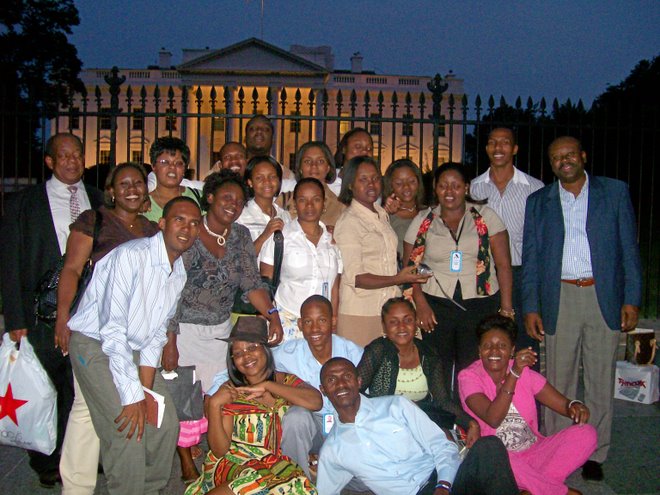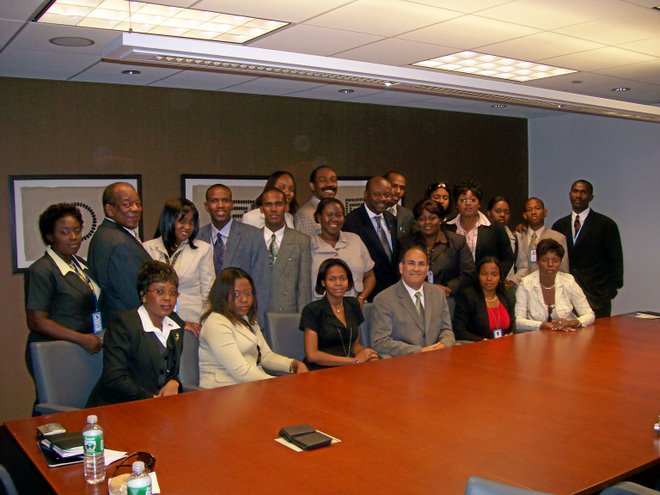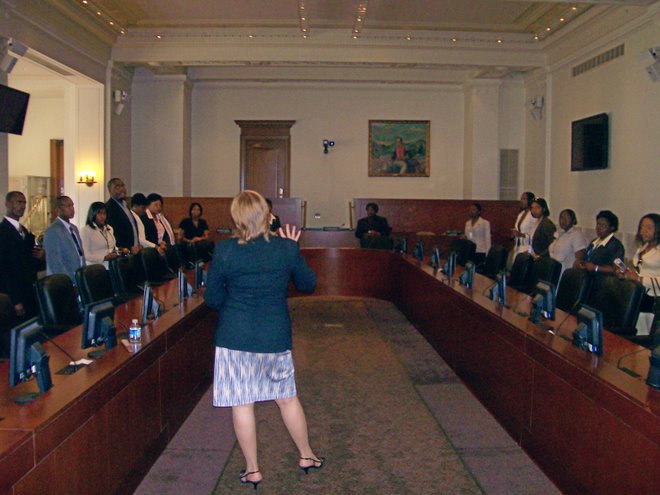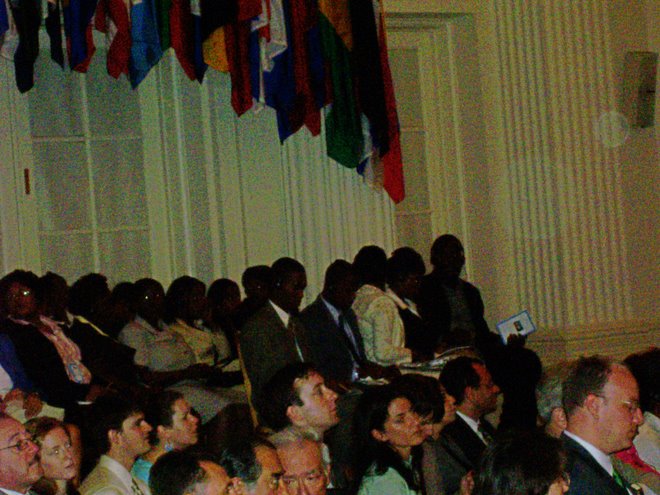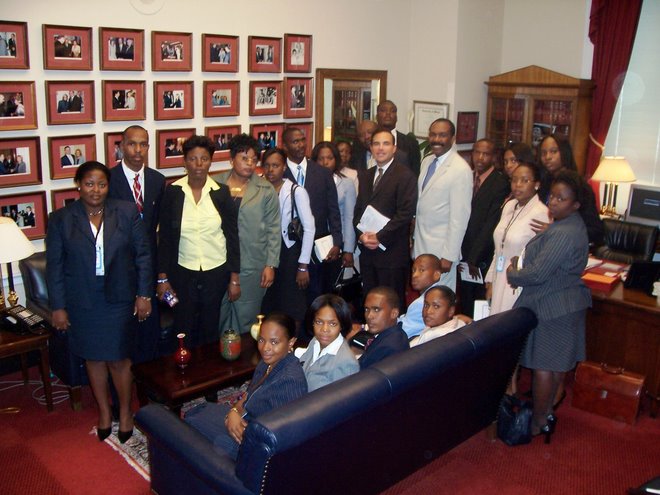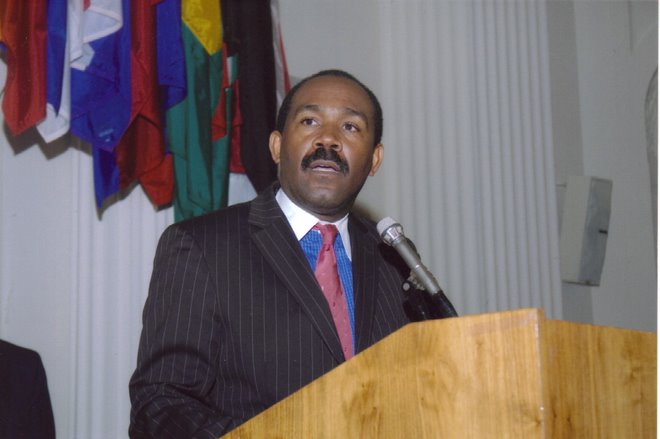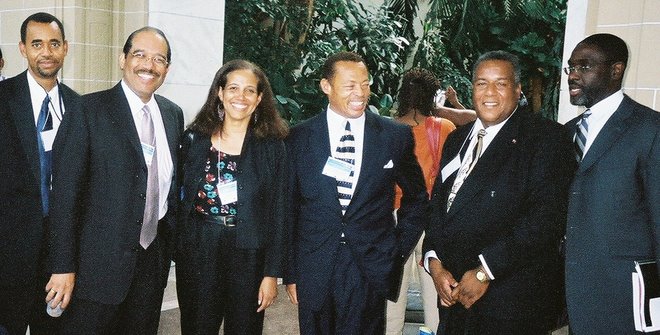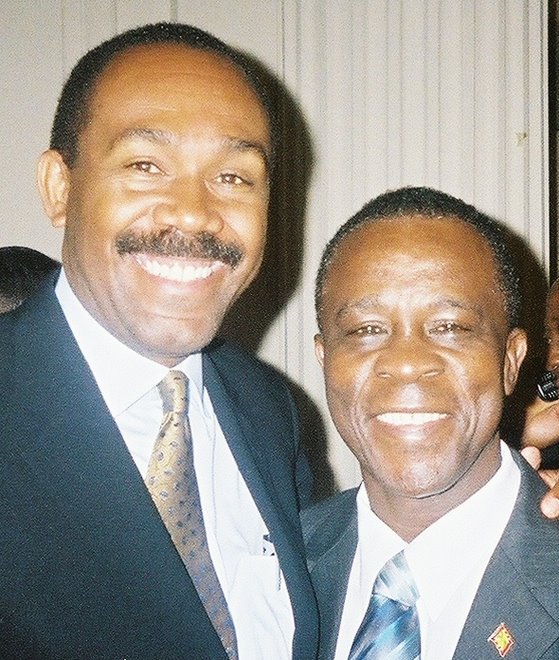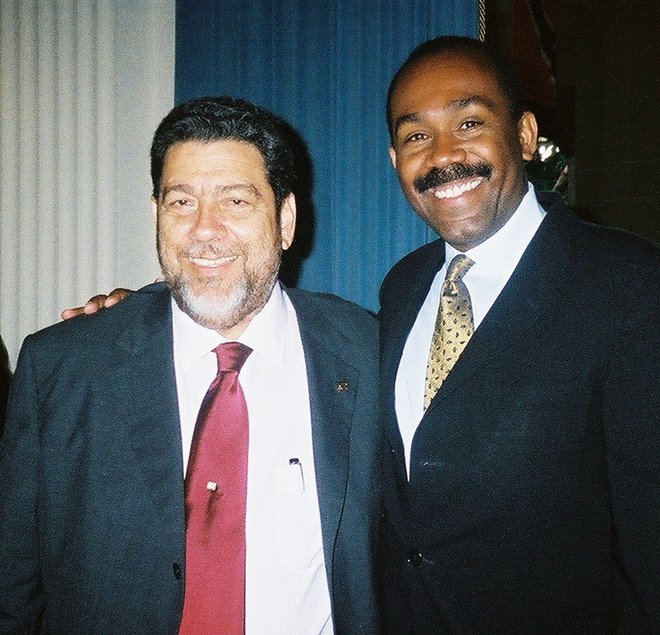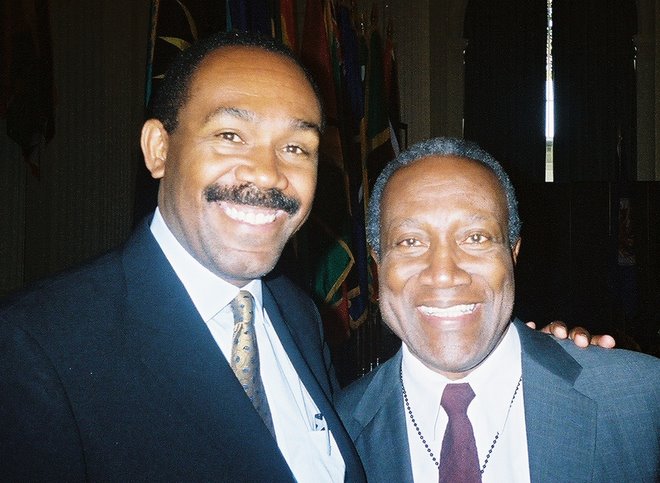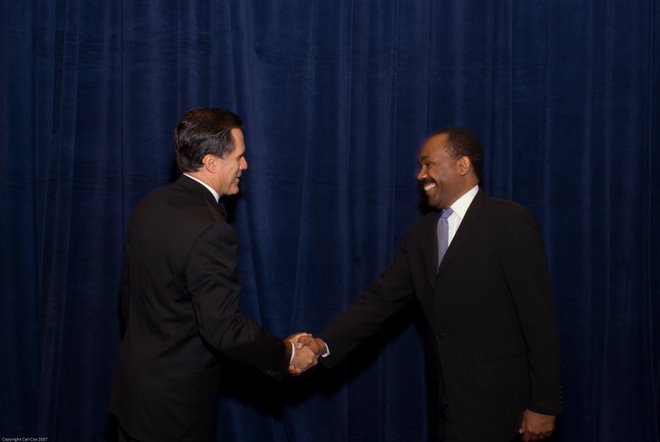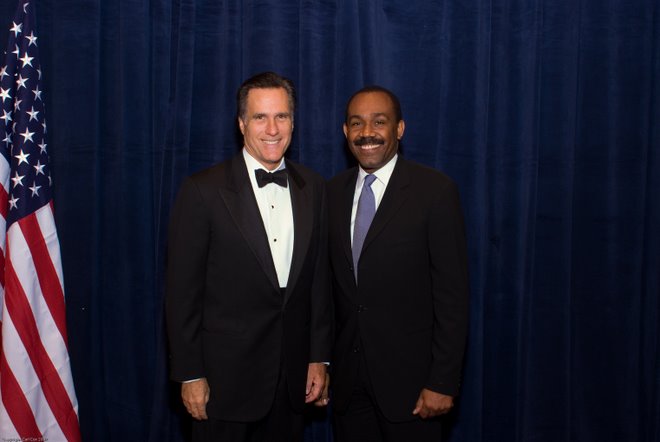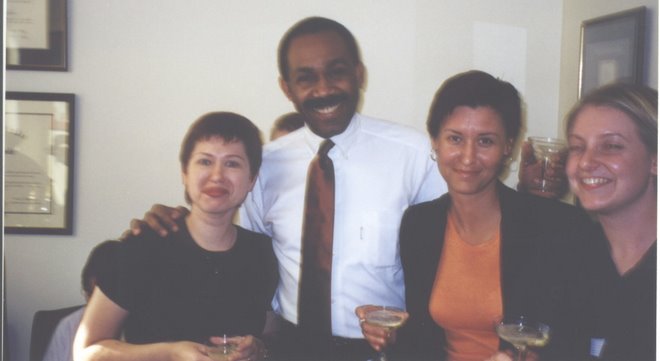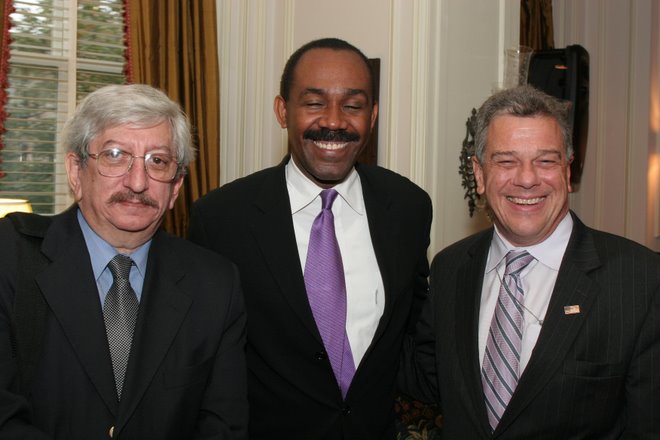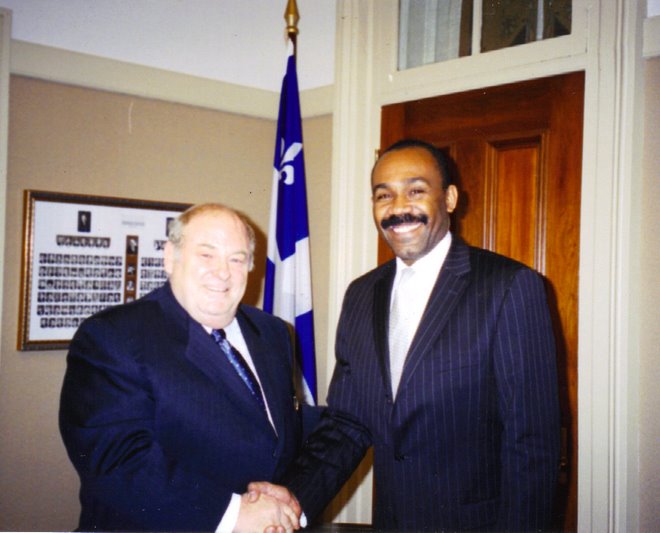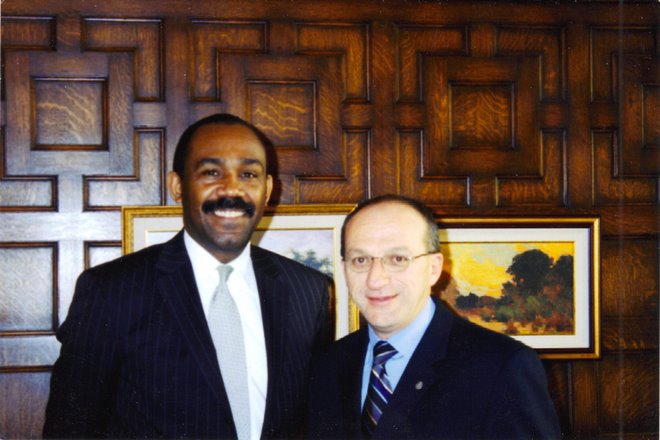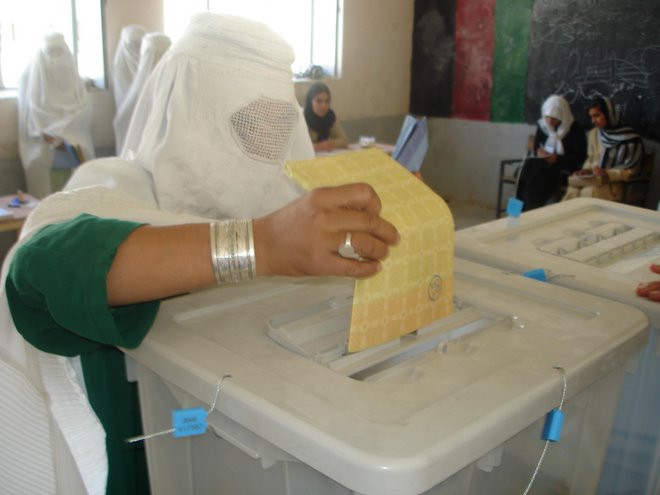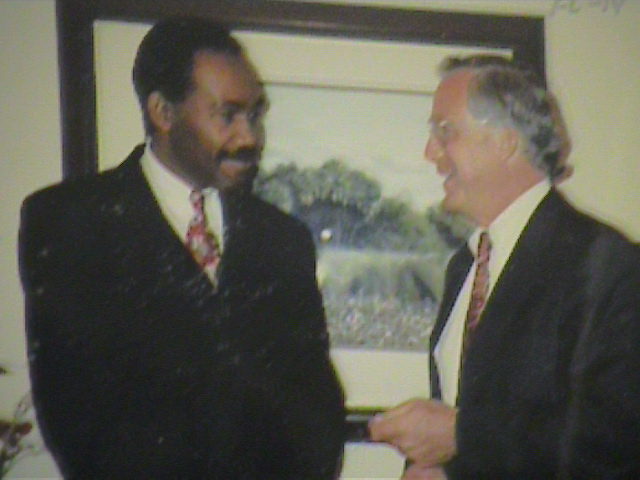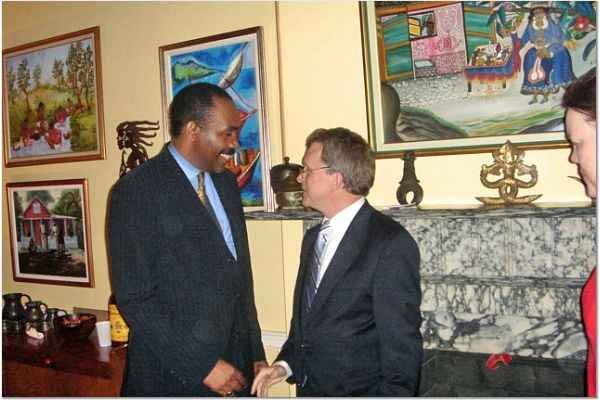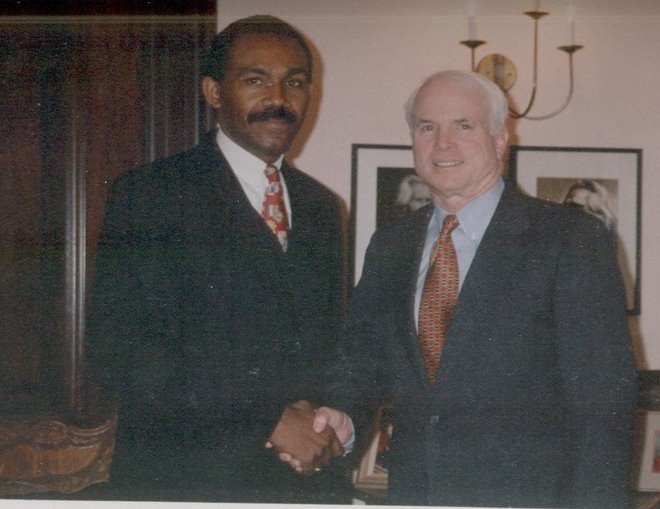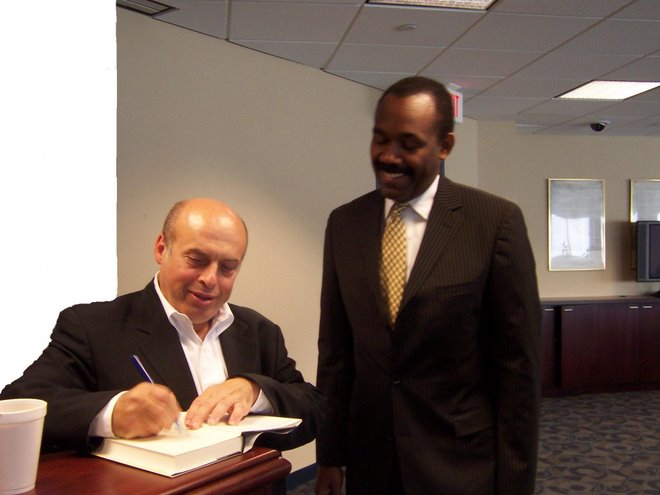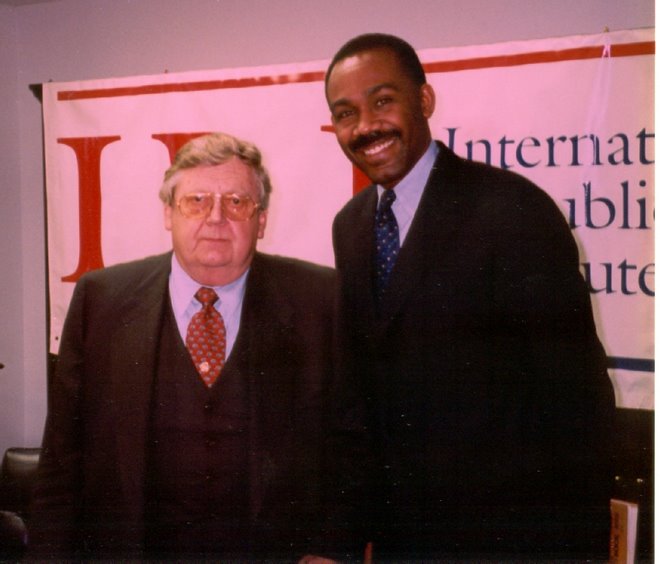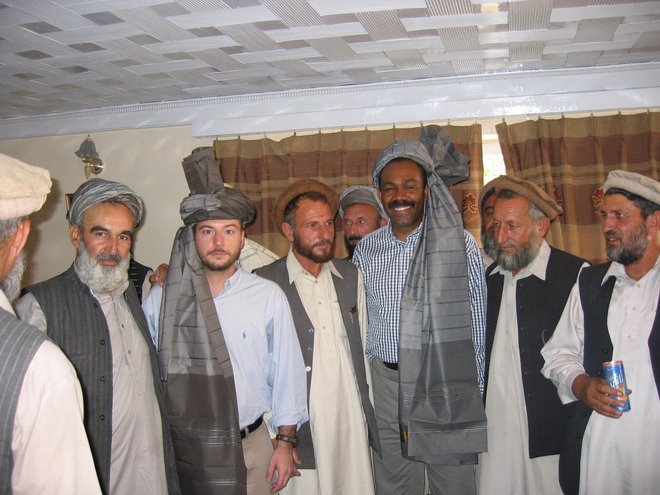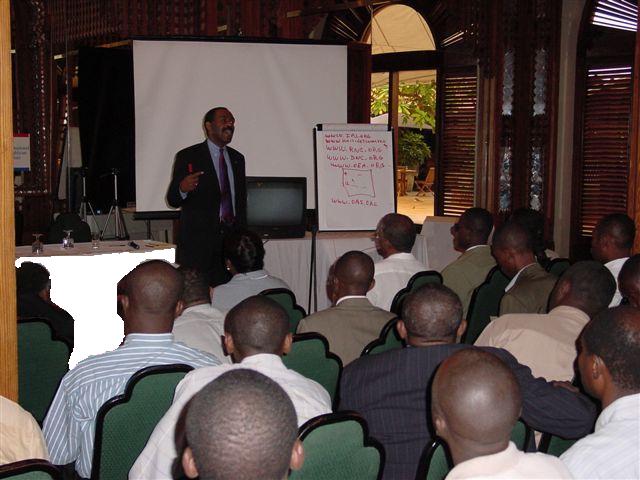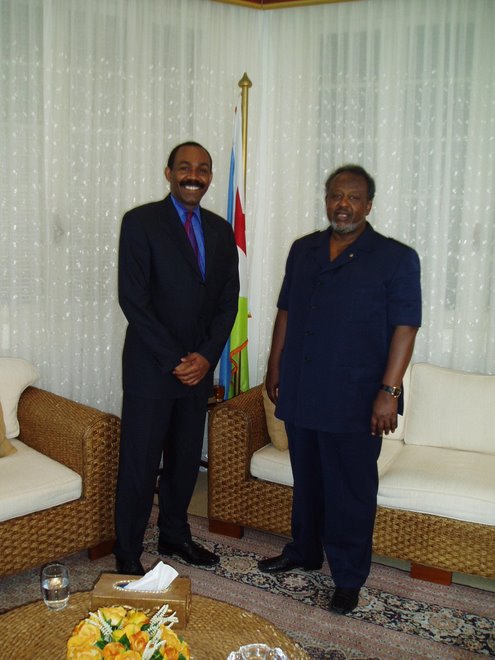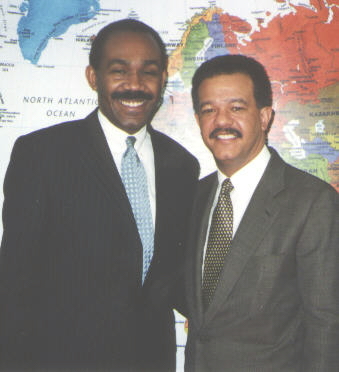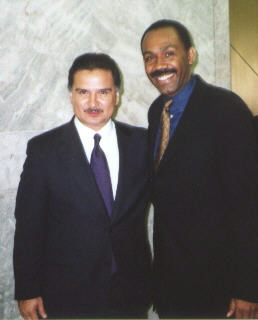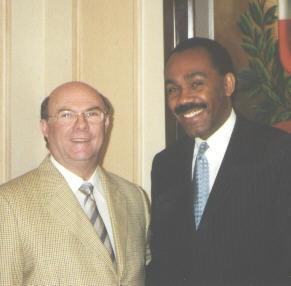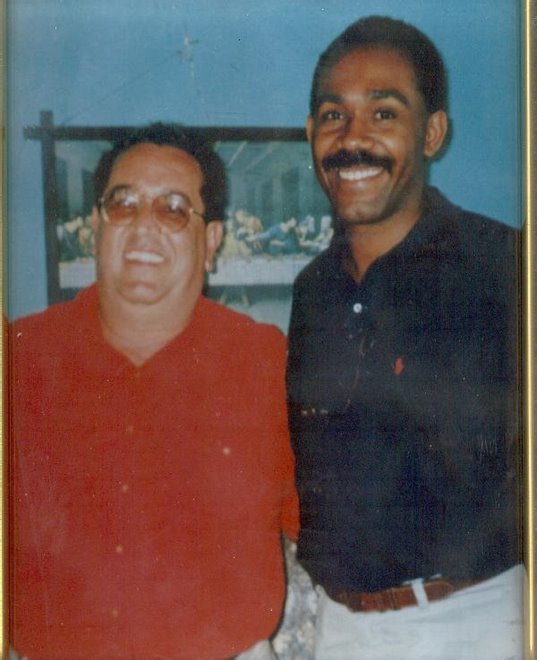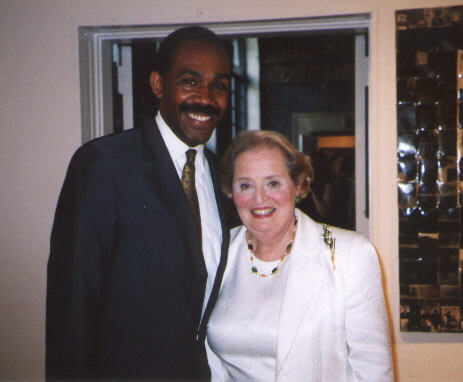Photo de Jean Bertrand
Aristide a la Maison Blanche quand il demandait officiellement l'occupation d'Haïti
en 1994.
Ce 15 Octobre 2013 ramène le dix-neuvième
anniversaire de l’occupation militaire des Etats Unis en Haïti sollicite par le
Président Jean Bertrand Aristide en 1994. Le peuple Haïtien attend toujours des excuses de Jean Bertrand Aristide. C’est le moment de rappeler pour les générations
futures que cette demande officielle d’occupation militaire d’Aristide était un
acte de trahison parce qu’elle viole la constitution d’Haïti. Aristide par cette décision mettait
aussi en veilleuse de la souveraineté nationale d’Haïti si chèrement acquise
par les pères de l’indépendance. Nous ne devons pas non plus oublier qu’après
la demande d’intervention militaire de Jean Bertrand Aristide alors que les
bateaux, avions, engins militaires et la machine de guerre des Etats Unis étaient
déjà en route pour bombarder Haïti, n’était-ce l’action diplomatique de dernière
minute de l’ancien Président Jimmy Carter, du General Colin Powell et du Sénateur
Sam Nunn des milliers de citoyens haïtiens auraient pu perdre la vie et vivre
les moments inoubliables de la guerre avec les bombardements, la mitraille et
autres psychoses que cela laisse sur tout un peuple. Grace a leur intervention,
l’invasion brutale sollicitée par Aristide l’homme des occupants qui n’avait
pas hésite a donner le feu vert a pu être évitée. Bay kou bliye pote mak sonje! Se pa yon ti dezod tankou Aristide te
dil, se te yon gwo trayizon!

Dessalines pat nan achte figi
De la demande officielle d'embargo contre Haïti
en 1992, en passant par la demande officielle d'intervention militaire en Haïti
en 1994 ou encore l'invitation officielle des troupes militaires de l'Afrique
du Sud le 1 Janvier 2004 aux Gonaïves pendant que nous étions en train de
célébrer nos 200 ans d’indépendance, voir: http://metropolehaiti.com/metropole/archive.php?action=full&keyword=mbeki+aux+gonaives&sid=0&critere=0&id=7742&p=1
et sa dernière demande officielle pour l'envoi de 3000 soldats américains en Haïti
en Février 2004, l'ancien Jean Bertrand Aristide a viole la constitution de
1987, trahi sa patrie et vendu la souveraineté nationale d’Haïti. Les demandes
d'interventions militaires sollicitées officiellement par un Président de la république
d'Haïti sont condamnées par la constitution de notre pays qui considèrent ces
actions comme un acte de haute trahison. Dix neuf ans après Jean Bertrand
Aristide et Fanmi Lavalas n’ont toujours pas présente des excuses au peuple Haïtien
pour ses demandes répétées d’occupations qui ont hypothèque la souveraineté
nationale de notre pays.

Aristide devant le Pentagon recevant les honneurs militaires apres avoir sollicite l'occupation d'Haiti
L’histoire de l’occupation récente de la république
d’Haïti par des troupes étrangères a commence en 1992. Le Président
constitutionnel Jean Bertrand Aristide victime d’un coup d’état illégal le 30
Septembre 1991 partira en exil. Une fois a l’étranger, dans le cadre de son
plan pour la reconquête du pouvoir politique, Jean Bertrand Aristide, prendra unilatéralement,
sans consultation avec le parlement haïtien et les forces démocratiques d’Haïti
un ensemble de décisions qui ruineront l’économie d’Haïti avec des impacts
sociaux déplorables appauvrissant
tout une population tout en vendant la souveraineté nationale.
Pour commencer, Jean Bertrand Aristide pour
retourner au pouvoir décida d’imposer en 1992 un embargo économique sur Haïti
en lieu et place de sanctions ciblées contre les responsables du coup d’état.
Les résultats de ces sanctions imposées par Aristide avec le support de ces
allies de la communauté internationale seront catastrophiques pour Haïti et son
peuple. Les plus démunis et les classes moyennes ont été les plus grandes
victimes de l’horreur dénommé embargo impose par Aristide. Comment un Président
d’Haïti a-t-il pu commettre une telle ignominie ? L’embargo Aristide tuera
des milliers d’enfants selon une étude de l’UNICEF et de l’université américaine
Harvard. Il a eu un impact terrible sur les femmes, la sécurité alimentaire et
le système de santé causant la malnutrition, le manque de médicaments dans les
centres de sante et l’accès aux soins de base.
Les vendeurs de notre patrie au Pentagon en 1994
L’embargo d’Aristide a fait perdre 300.000
emplois a Haïti et détruira l’environnement a cause de l’accélération du déboisement
du au blocage maritime militaires bloquant la plupart des importations inclut les
produits pétroliers. L’horreur économique de l’embargo avec ses conséquences
comme par exemple la famine causant la malnutrition générale, poussa les citoyens à quitter le pays a
la recherche d’opportunités pour faire vivre leur famille. Malgré les horreurs économiques
et sociaux de l’embargo qui frappaient les enfants, les jeunes, les femmes, les
hommes et les vieillards, Aristide déshumanise continuait a scander a la radio
qu’il fallait augmenter les sanctions. Les copies audio de ces déclarations
sont encore disponibles dans toutes les stations de radios d’Haïti et de la
diaspora malgré les efforts et les gros moyens déployés par Aristide pour faire
disparaitre la documentation audio, vidéo et écrite de ses crimes contre son
peuple.
Gade yo kap siyen...
Jean Bertrand Aristide demanda officiellement
aux Etats Unis de le restaurer au pouvoir avec 20.000 soldats et l’Agence Américaine
d’Intelligence (CIA). La stratégie d’Aristide pour reprendre le pouvoir
comprendra deux axes. L’axe interne et l’autre externe. Au niveau interne:
1.
Fabriquer et projeter devant l’opinion publique et la communauté
internationale des violations massives de droits humains. C’est vrai que les militaires et l’organisation paramilitaire FRAPH étaient
responsables de nombreux violations de droits humains pendant la période du
coup d’état mais c’est aussi vrai qu’avec son réseau Jean Bertrand Aristide
faisait voler a travers les morgues des hôpitaux du pays des cadavres de
citoyens morts naturellement pour les cribler de balles pour ensuite les déposer dans les rues d’Haïti
pour gonfler le dossier des droits humains.
2.
Utilisation de ses réseaux politiques pour distribuer de l’argent pour
construire des bateaux et provoquer un flot massif de boat people vers Miami. Dans le cadre de la préparation
de ce scenario boat people le teledjol Haïtien avait identifie a l’époque le
Maire Lavalas de la commune de Delmas comme celui qui avait distribue l’argent
pour construire les bateaux qui allaient transporter des milliers de citoyens haïtiens
des milieux ruraux d’Haïti vers Miami. Il n’attendait que le signal donne de Jean
Bertrand Aristide qui était à Washington travaillant activement en ce sens. Le
milliers de gens en mer qu’on verra plus tard sur CNN plus tard était le coup
boat people organise et prépare par Aristide pour forcer Clinton a intervenir
en Haïti sur sa requête.
Au niveau externe:
1.
Employer des lobbyistes pour préparer et gonfler l’opinion publique
pour une intervention militaire. Tout un réseau de
lobbyistes avait été employé par Aristide avec les 80 millions de dollars de la
teleco qui étaient dans les banques américaines. Michael Barnes le chef de la campagne de Bill Clinton dans le
Maryland était parmi les employés ainsi que de nombreux proches du Concrétionna
Black Caucus incluent Randal Robinson et sa femme Hazel étaient sur le payroll.
Ils deviendront tous millionnaires sur le dos du peuple haïtien. Les 80
millions de la teleco d’Haïti se sont envoles dans les poches de ces messieurs
et ceux d’Aristide. Leur rôle était de pousser l’administration américaine vers
l’intervention militaire a travers des articles de journaux, la grève de faim
de Randal Robinson devant la Maison Blanche tout en plaçant des éléments clefs
et favorables dans des positions stratégiques a l’intérieur de l’administration
Clinton. Ces influences leur permit de faire revoquer l’Ambassadeur Lawrence
Pezzulo et le remplacer par un proche de Congressional Black Caucus (CBC) et
Aristide, William H. Gray. Le
livre non publie de Pezzullo “The Leap into Haïti: Or How Not to Conduct U.S.
Foreign Policy in the Post Cold War” offre des détails intéressants sur comment
Aristide a planifie, sollicite et obtenu l’intervention militaire des Etats
Unis pour le restaurer au pouvoir en Haïti.
2.
Utilisation les missions diplomatiques d’Haïti a Washington, Nations
Unies, OEA et la CARICOM pour faire avancer le dossier de l’intervention
militaire. En plus de la demande formelle d’occupation
militaire de Jean Bertrand Aristide, il utilisera les missions diplomatiques
pour les requêtes formelles dans les institutions multilatérales et rapports bilatéraux.
Quatre missions diplomatiques d’Haïti ont joue un rôle clef dans l’agenda de la
demande d’occupation voulu par Aristide: Washington, l’OEA, les Nations Unies
et la CARICOM. En plus la mission de Washington jouait un rôle additionnelle
pour faciliter l’occupation: payer des journalistes américains charges de
publier des histoires préparées par Aristide et les lobbyistes qui
travaillaient le Congres et l’Administration pour faire avancer le dossier de
l’intervention.
3.
Demander officiellement l’intervention militaire aux autorités américaines
pour le restaurer au pouvoir demanda officiellement au pouvoir en Haïti. Prière de consulter la vidéo d'Aristide remerciant au Pentagone le
Ministre américain de la Défense William Perry et le General Shalikasvili,
cliquez ici: http://www.c-spanvideo.org/program/60373-1

Aujourd’hui il y a dix neuf ans Aristide
sollicitait officiellement de la Maison Blanche et du Pentagone une
intervention militaire en Haïti pour le restaurer au pouvoir en Haïti. Aristide,
en prenant la décision de faire envahir Haïti en Septembre 1994, par des
militaires étrangers n'avait consulte que ces conseillers proches Casimir,
Longchamp, Woerleigh qui etaient avec lui aux Etats Unis. Dans sa campagne de
sollicitation officielle de l'occupation de la république d'Haïti, Aristide mit
catégoriquement de cote les sénateurs et députes la 45e législature et les forces
politiques du pays. Il mit aussi de cote ses allies politiques en Haïti opposes
a sa demande d'occupation. A l'époque Gérard Pierre Charles de l'Organisation
du Peuple en Lutte (OPL), Jean Marie Vincent et d'autres membres du mouvement
lavalas qui constituaient le front interne contre le coup d'état militaire étaient
contre l'intervention militaire étrangère en Haïti. Les membres du front interne lavalas de résistance
combattant le coup d'état pensaient pouvoir réinstaller l'ordre démocratique en
Haïti sans occupation militaire étrangère. Aristide voulant l'intervention
militaire des étrangers pour revenir au pouvoir était en conflit avec ce groupe
de lavalassiens de l'intérieur oppose a l'occupation. Cette différence causa
l'assassinat de Jean Marie Vincent selon les analystes qui attribuèrent le
meurtre à Aristide.
Jean Bertrand Aristide le demandeur officiel
de l'occupation militaire du 15 Octobre 1994 sera-t-il encore silencieux ce 15
Octobre 2013 ou finalement demandera-t-il pardon à la nation?
C'est aussi Jean Bertrand Aristide qui
introduira les soldats de l'ONU en Haïti, il remplacera les militaires américains
par les militaires des Nations Unies en 1995. A cause de la politique interne, les autorités américaines décidèrent
de rapatrier leur troupe en Haïti. Pour les remplacer Jean Bertrand Aristide
fit une demande de soldats étrangers à l’ONU qui accepta. Cette première
mission militaire dut déployée en Haïti, à l'époque elle portait le nom de MINUHA.
De 1994 a 2004 Aristide a sollicite
officiellement douze demandes d'occupations. En 2006 René Préval, Jacques
Edouard Alexis continueront cette politique de renouvellement de l'occupation. De
2006 a 2011 ces responsables de l'état n'ont jamais présente à la nation le
plan de reconquête de la souveraineté nationale d'Haïti a travers le
renforcement et la reconstruction de nos institutions de sécurité. La mise en
place d'une stratégie de sécurité nationale ne fait pas partie de leurs
priorités. Apres Lavalas ce sont le CPP, l'INITE et Louvri Barye qui choisirent
l'occupation.
Aristide débarqua a Port-au-Prince le 15
Octobre 1994 dans un avion américain, puis fut déverse au palais national par
un hélicoptère de la marine américaine. Aristide était fier de sa performance,
il racontait à ses conseillers proches comment il a roule Bill Clinton.
Sachant qu'il avait viole la constitution en
sollicitant et provoquant cette intervention militaire, Aristide déclara plus
tard dans un discours a la population que "li fe yon ti dezod".
Randall Robinson fut récompense par Aristide a
travers les millions que recevra plus tard sa femme Hazel Robinson de l'état Haïtien
a travers des contrats de lobbyistes. Pour les détails cliquez ici: http://www.haitipolicy.org/Lobbying7.htm
Le livre de Robinson devait
servir pour la réalisation d'un film pro Aristide sur l'histoire d'Haïti.
Depuis honteux et maltraites par des historiens
Haïtiens pour ses choix d'occupations Aristide utilise des faux noms et
quelques proches a son service sur l'internet, l'un deux, Joël Léon, pour
promouvoir une propagande qui vise a changer l'histoire des demandes
officielles d'occupations d'Haïti faites par lui.
Aristide sera-t-il silencieux ce 15 Octobre
2013? Je suis certain qu'il le restera encore cette année.
Concernant la demande d'occupation de 1994 les
journalistes Haïtiens devront demander a Titid , l'homme des occupants,
pourquoi ne pouvait-il pas avoir le comportement noble du président Manuel Zelaya du Honduras qui est
rentre chez lui sans solliciter un soldat étranger après le coup d'état militaire
contre lui? Il faudra aussi demander au Lavalas et a LESPWA-INITE qui etaient
au pouvoir depuis vingt ans pourquoi Haïti comme l'Irak n'a-t-elle pas son plan
de reconquete de la souverainete nationale pour le retrait progressif des
troupes etrangeres? Est-ce que
c’est parce qu’ils eaient les hommes de l’occupant qu’ils n’ont pas pu parler
de la reconquete de la souverainete nationale?
Quand a Michel Martelly il a propose le 18
Novembre 2011 un plan de reconquete de la souverainete nationale qui passe par
la professionalisation de la police, la construction d’une armee professionnelle
et le retrait organise de la MINUSTAH. Mais ce sont les memes arnacho
populistes lavalassien Moise Jean Charles, Simon Desras qui ont fait du
lobbyong a Washington pour dire qu’Haïti n’avait pas besoin d’une armee.
Martelly a donc renouvele le mandat de la MINUSTAH.
Pour les etudiants qui choississent ce theme
pour leur these, un petit rappel des demandes recentes et officielles
d'occupations en Haïti.
Il y a eu beaucoup de debats autour de l'idee
de "l'occupation etrangere" en Haïti. les Haitiens, bien sur, sont
opposes a cette idee. Quelques
leaders Haitiens au pouvoir pour leur capital politique ont essaye de manipuler
les faits pour ne pas assumer la responsabilite d'avoir demande officiellement
l'intervention militaire des etrangers en Haïti. Les faits sont que de 1990 a
nos jours quatrorze missions etrangeres de formes variees ont ete deployer en Haïti,
a chaque fois, a partir d'une requete officielle du Gouvernement Haitien en
fonction. Les documents officiels sont disponibles pour prouver que ces
requetes ont effectivement ete faites. Voici la liste:
Assistance technique des Nations Unies
sollicitee par le president Ertha Pascale Trouillot en 1989 pour supporter l'organisation des elections elections
de 1990
Demande de l'imposition d'un embargo
economique des Nations Unies sur Haïti sollicitee par le president Jean
Bertrand Aristide en 1991
Demande de l'envoi d'une mission des Nations
Unies,MICIVIH, en Haïti sollicitee par le president Jean Bertrand Aristide
Fevrier 1993 a Mai 1998
Demande d'intervention militaire des Etats
Unis en Haïti sollicitee par le president Jean Bertrand Aristide en Septembre
1994
Requete d'une mission militaire des Nations
Unies,UNMIH, en Haïti sollicitee par le president Jean Bertrand Aristide
Septembre 1993 qui a termine sa mission en Juin 1996
Requete d'une mission militaire des Nations
Unies en Haïti, UNSMIH, sollicitee par le president Rene PrevalJuillet 1996 a
Juillet 1997
Requete d'une mission militaire des nations
Unies en Haiti,UNSMIH, sollicitee par le president Rene PrevalUNTMIH Aout 1997
a Novembre 1997
Requete d'une mission militaire des Nations
Unies en Haiti,UNSMIH, sollicitee par le president Rene PrevalMIPONUH Decembre
1997 a Mars 2000
Requete d'une mission militaire des Nations
Unies en Haiti,UNSMIH, sollicitee par le president Rene PrevalMICAH, Mars 2000
a Fevrier. 2001
Requete d'intervention d'Aristide a
l'administration Clinton, les huit points, sollicitee par Jean Bertrand
Novembre 2000
Requete d'une mission militaire des Etats Unis
en Haïti sollicitee par le president Jean-Bertrand Aristide Janvier 2004
Requete d'une mission militaire des Nations
Unies en Haïti sollicitee par le president Jean Bertrand Aristide Janvier 2004
MINUSTAH April 2004 a nos jours ;
Aristide a aussi sollicite l'intervention de
l'OEA 2000 a 2007 , toujours en Haïti
Aristide a sollicite l'intervention de la
CARICOM 2001 a 2004
Michel Martelly renouvelle le mandat de la
MINUSTAH 2012-14

















































































































































-3.jpg)


.jpg)





.jpg)











.jpg)
.jpg)
.jpg)
.jpg)
.jpg)
.jpg)


















